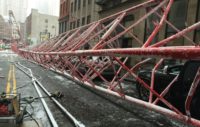Bigge Crane & Rigging Co. and a company engineer, Claus Frederiksen, are the targets of a lawsuit, filed by both Entergy Arkansas and Entergy Operations, that claims the heavy-lift contracting giant failed to perform a load test prior to a fatal crane collapse at the two-unit Arkansas Nuclear One station on March 31.
The lawsuit, filed on July 12 in Pope County Circuit Court, accuses Bigge, one of the largest in its sector in the U.S., of "gross negligence."
Through a spokesman, Bigge declined to comment.
Entergy Arkansas and Entergy Operations—owner and operator, respectively, of the Arkansas Nuclear One (ANO) station—demand a jury trial and seek an unspecified but substantial financial award.
ANO Unit 1, an 836-MW pressurized-water reactor, was shut for an outage that included generator upgrades when a 550-ton stator—part of the generator for Unit 1—fell 30 ft while it was being removed from the turbine hall.
The collapse killed an ironworker and injured several other workers.
The damage caused ANO Unit 2, a 987-MW unit, to trip. Unit 2 started its return to service on April 28 and reached full power on April 30.
Entergy Arkansas and Entergy Operations allege that Bigge—a subcontractor to Siemens Energy, which had won a contract to perform the stator project—and Frederiksen failed to follow the common practice of making a load test to ensure the adequacy of the temporary gantry they installed to lift and move the stator.
Entergy’s Nuclear Management Manual requires that temporary hoisting assemblies be designed for at least 125% of the projected hook load and that the assemblies undergo a five-minute load test, again at 125% of projected load.
The plaintiffs also say Bigge and Frederiksen made an “inaccurate representation that the gantry had been used in the same configuration to lift equipment that exceeded the anticipated weight of the Unit 1 stator,” as well as an inaccurate statement that a load test on the gantry was not possible at the ANO site.
Gantry Components Cited
According to the suit, at least three components of the gantry were new “and therefore had no load history and had never been used before in combination with the other components of the gantry” used at ANO.
Further, according to the suit, while the gantry system was designed so it would be pinned to the turbine building during installation, Frederiksen’s design “called for these anchor pins to be removed following completion of the assembly process. This resulted in a free-standing gantry.”
According to the suit, on March 31, the Unit 1 stator was lifted and transported across the turbine deck floor and was in the process of being turned 90 degrees to align it with the opening on the turbine deck through which it would be lowered when the gantry collapsed, causing the stator “to fall to the turbine building floor and roll into the train bay.”
The suit states the turbine building “suffered significant structural damage in the train-bay area and significant damage to the structural support directly beneath the Unit 1 and Unit 2 turbine decks that also affected the safe operation of Unit 2. Mechanical and electrical systems were damaged and/or destroyed.”
Entergy Arkansas and Entergy Operations say in the suit that they continue to suffer economic losses from the incident, noting that Unit 1—which Entergy Arkansas says may remain off line until late this year—is a base-load unit that typically operates at full power 24/7.
Entergy Corp. said in an 8-K filing on May 20 to the U.S. Securities and Exchange Commission that while it was still analyzing the incident and the extent of the damage, the total cost of assessment, debris removal and replacement of damaged property and equipment at ANO was estimated to be “in the range of $130 million to $215 million."
The firm noted, however, that the estimate “may change as restoration efforts continue and more detailed analysis is performed.”
The U.S. Occupational Safety & Health Administration is conducting an investigation into the events surrounding the incident at ANO. A spokesman for OSHA’s Dallas office has not responded to a request for comment about the status of that probe.



